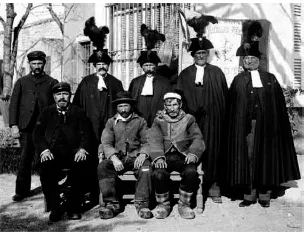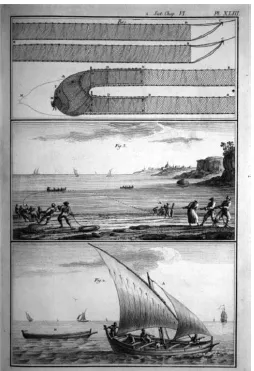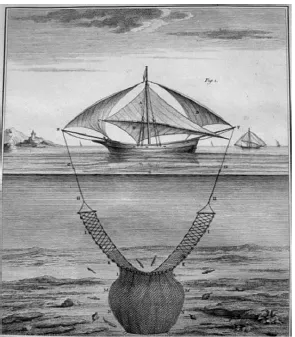![]()
1
Fishing in the Mediterranean, Past and Present: History and Technical Changes
The historical context of the maritime sector can present certain difficulties for historians and fishery specialists. Seas and oceans are mostly worlds without archives, often mistakenly thought of as immutable. Most often glossed over by biologists, more than ever does it seem necessary to ask questions about the past of the underwater world. It must today be at the heart of all reflections that condition the defining of policies for the management of fisheries. While the challenges faced by Mediterranean fishing, climate change, acidification and the need for a rigorous management of stock, are no different from those found in all seas of the world, they are all the more applicable in this closed basin and must engage the responsibilities of all the surrounding states in the 21st Century. Dedicated for millennia to fishing and the movement of men and goods, this “liquid continent with a solid border”, as it was called in the 1930s by the poet Gabriel Audisio and his friends from the Cahiers du Sud, has witnessed the rise of new uses in the last 50 years, which present important problems for fisheries. The rise of leisure fishing, harm to coastal fishing caused by the damaging of marine ecosystems and the need to provide for urban and tourist markets increasingly demand of sea products today, influence the maintenance or the survival of professional fishing in all of the basin. However, the long history of Mediterranean fishing, far from unmoving, shows that the men and women who formed it over centuries were able to adapt their methods to the fluctuating conditions of access and exploitation of fishing resources. The future of fishing in the Mediterranean requires mastering the effects of industrialization and urbanization on ecosystems, also must take into account the cultural aspects, including traditional expertise, for a better management of this medium. Compiling a comprehensive history of fishing would appear unfeasible in the confines of this chapter. A choice has therefore been made first to present a reflection on historical methods of fishing. A table of traditional techniques, the organization of communities and their plurality is envisaged here (section 1.1). Second, the successive changes that have transformed this activity sector since the modern era are analyzed (sections 1.2 and 1.3). The third component of this approach proposes some reflection on the characteristic of Mediterranean fishing at the start of the 21st Century. This last part will be a description of the current flotillas in operation, while looking at the challenges faced by this sector of activity: environmental changes, changes in how people consume, the redefining of the fishing boss, between collective needs for the protection of the habitat and the need to fulfill the demands of the market (section 1.4).
1.1. Mediterranean fishing of the past (18th Century)
Structured by religious brotherhoods and communal efforts, fishing communities efficiently control the exploitation of the natural medium in the modern era. The large variety of fishing techniques used, as well as the characteristics of an “Ancient Regime” style of consumption, marked by a chronic lack of protein, explains the extreme diversity of the products offered at the fishmonger’s stall.
1.1.1. Brotherhoods and prud’homies: old forms of regulation of the fishing world
Being present as early as the 15th Century on the north coast of the Mediterranean, the brotherhoods, Italian confraternite, Catalan gremis or the Spanish cofradias, appeared as the dominating form of organization in the fishing community. Placed under the protection of the Virgin Mary or a patron saint, Saint Peter, Saint Elme or Saint Roch, the brotherhoods were first of all religious structures that not only guaranteed their members’ collective solidarity in the case of an accident (loss of ships or fishing materials), but also looked after the souls of the dead through prayers and processions. They were also professional regulatory structures. Made up of all the fishing bosses, i.e. the boat owners, they enacted precise fishing regulations, most often passed on orally. The distribution of fishing zones (the Provençale “postes”), the mesh size of the nets, the size of the hooks, the quality of the baits and a strict calendar fixed by the community [FAG 11], thus precisely defined the modes of exploitation of a “fishing ground” [FER 01] whose spatial limits are strictly delimited. The names used by the fishing communities of the past clearly illustrate this distribution of the marine space, which was split into microterritories: for example the two seas of Amoun and Avau, which split the organization of fishing in Marseilles in the 17th Century [FAG 11]. Exceptionally, the organization of the community would depend on two structures: the prud’hommes, a tribunal made up of representatives of the profession, are clearly distinguished from the brotherhood, which would in this case be reduced to a spiritual function and a function of assistance. The only jurisdiction in all of the ports of the Mediterranean, the corporation of prud’hommes of Marseilles would appear today as the most accomplished form of self-regulatory organism for fishing activities [BER 98]. It benefits from its age, since the municipal authorities allow the community as early as the 14th Century to choose its own probi homines, its wise men, to sort out any conflicts related to fishing. There are four of them, renewed each year and elected by a simple vote by show of hands. These Marseilles prud’hommes provide public justice, orally, freely and without the possibility of appeal. A tribunal of experts and recognized as such, the Marseilles prud’hommes thus avoid the suppression of corporations put in place by the revolutionary laws of the 2nd and 17th March [FAG 11]. A model of professional organization, as early as the last decade of the 18th Century, it became the dominating form of justice within the fishing communities of the French Mediterranean coast.
Figure 1.1. Provençale fishing prud’hommes
(source: Musée Ciotaden)
COMMENTS ON FIGURE 1.1.– As Mediterranean fishing boss communities, the prud-hommes appeared for the first time in Marseilles in 1481, officially recognized by Louis XI’s royal charter. Extended to all fishing communities after the French Revolution, the prud’homme form of organization found its definitive form in a decree from 1859. The function of the prud’hommes is to sort out conflicts between fishermen and regulate the access to fishing zones depending on their jurisdiction. Long neglected by the legal authorities, especially during attempts to develop industrial fishing, they have been, since 1994 by decree of the Affaires Maritimes, systematically consulted before any regulation is made in maritime affairs. As a decentralized power of management and authority, the prud’hommes constitute a model of management and governance of fisheries ensured by the polyvalence of the activities and making the fishers aware of their responsibility, which are the optimal conditions for the proper exploitation of the resources. “The five prud’hommes wore hose, a doublet and a black coat with a white band. On their heads they wore a hat with large edges. Their faces were tanned, and they represented the elite of the maritime population of the town and of the gulf” [SUE 45].
1.1.2. Plural communities
Present over the entire Mediterranean coast, traditional fishing communities offer much diversity. The differences first concern the forms of habitat and insertion in the coastal space. From the simple Languedoc or Moroccan rosewood hut [FER 01, PAY 07] to the specific urban quarter, the fisherman’s habitat appears as the result of natural conditions (dirtiness of the coast), and also depends on historical processes that can reflect the age of a community (Saint-Jean quarter in Marseilles, Jonquières quarter in Martigues, etc.), or reflect political decisions, often made later (Barceloneta quarter in Barcelona, created from scratch in 1753, La Bordigue quarter in Sète, after the 17th Century) [CAB 95]. On top of these differences in accommodation, a plurality of the activities that are not entirely dedicated to fishing can be added. Better than the classes system etablished by the French Royal administration, the study parish registers also frequently highlights the professional instability of the people of the sea, successively recorded professionally as “brassiers”1 rather than fisher2.
Like for the Atlantic coast, the presence of a cultivatable inland explains the coexistence in the Mediterranean, within fishing families, of time dedicated to the cultivation of wine grapes or wheat and periods dedicated to fishing. The availability of agricultural resources, which sometimes transforms income taken from the sea into significant revenue, explains the choice of one type of fishing over another by communities. In the Languedoc and Roussillon, the fisher-winemakers of Leucate, Banyuls or Collioure, masters of the sardinal3 or of small fishing in lagoons, thus opposed the fishing owners of Gruissan or Sète in the 18th Century, who were converted to the pêche au boeuf 4 very early on (section 1.2) [LAR 97]. For the most part an opportunist, able to make the most of any positive variations offered by the resource, the traditional fisherman adapts his trade according to the season. He knows how to use the boguière or the thonaire5 with the same dexterity as the girelier6 or the eissaugue7, due to ancestral knowledge passed down from father to son. The use of all types of traditional fishing, more than the limits of his expertise, only depends on the financial capabilities that condition the buying of certain materials, whose cost is often greater than the value of the vessel itself.
1.1.3. Diversity of traditional techniques in the Mediterranean
Under the watchful eye of brotherhoods or prud’hommes, Mediterranean fishermen use in the modern era techniques that were already known in Antiquity, and often represented in mosaics of the Greco-Roman civilization, an example being the one found in the Villa del Casale in Sicily, dating back to the 3rd Century AD. Passed on through the vernacular, the expertise attached to these techniques is rarely the object of treaties or professional manuals. They are part of an oral culture of apprenticeship, provided on a vessel, aimed at sailors. The materials used can be classified into two categories. The first category is that of static gear, traps, coastal fishing lines, longlines and nets – whose extreme variety reflects the species that are being caught. Among these, we can distinguish bottom gillnets with a single aumée8, the trammel nets superimposing three aumées or net panels, aimed at catching benthic fish, gillnets floating on the surface, aimed at catching pelagic or semi-pelagic species (tuna, sardines, anchovies, etc.). This first group of static gears, opposed to all the mobile gear, is essentially composed of towed nets [MAR 05]. Whether manipulated from the coast by hand (Provençale eissaugue and Languedoc boulier), or from a vessel (gangui, Languedoc “peche a vache”, Albufera or Valence gànguil)9, these nets have the particularity of sweeping the posidonia prairies, the beds of silt or of coral sands, to find flat fish and elasmobranchii fish. Whether static or mobile, these different fishing gears are made up of fragile materials and are characterized by rapid wear. Their manufacture is supplied by a highly active artisan industry, mostly gone today, and their maintenance calls upon practices found on most of the Mediterranean coast. Nets made of hemp, which retain humidity, are subject to alteration, the damage caused by which delays the process of dying. This is carried out with the help of the bark from the Alep pine tree (Pinus halepensis), from which a decoction is obtained by boiling it in the community cauldron. The fish traps and crab traps (gireliers, Provençale emborniers and Spanish nansas) are most often made from myrtle sticks (Myrtus communis), their imputrescibility ensuring the longevity of the materials. If, for the most part, the manufacture of almadraba nets uses the same materials as those used in the elaboration of other fishing gear, the dimensions of these fixed fisheries and their maintenance costs are enough to put them in a class apart from that of small-scale artisanal fishing.
Figure 1.2. Eissaugue
(source: etching taken from Duhamel Du Monceau Henri Louis, Traité général des pêches, Guillaume de Bure, Paris, 1782)
COMMENTS ON FIGURE 1.2.– A dragged net manipulated from land, the beach seine is a piece of fishing gear whose history goes back to Antiquity. Called eissaugue in the French Provence, this net required a consistent coastal line, against a shallow infracoastal space free of rocks. This technique, maintained throughout the Middle Ages, preceded the growth from the 17th Century of open sea trawling. It was, however, still in use in the first half of the 20th Century.
Figure 1.3. Tartane
(source: etching taken from Duhamel Du Monceau Henri Louis, Traité général des pêches, Guillaume de Bure, Paris, 1782)
COMMENTS ON FIGURE 1.3.– At the end of the 17th Century, a new, powerful, polyvalent vessel appeared in the Mediterranean world. This new vessel was armed with a Latin sail. It was equipped with special nets with high sea fishing. With an important tonnage (between 30 and 50 tons, 1 ton = 2.83m3), this vessel was first built in Martigues (called tartana or martingana in 17th Century Italy). Parallel to the distribution of the sardinal, the development of the vessel was at the origin of the development of new activity, dragged fishing techniques at sea.
Figure 1.4. Gangui “à la vache or plow” fishing
(source: etching taken from Duhamel D...



